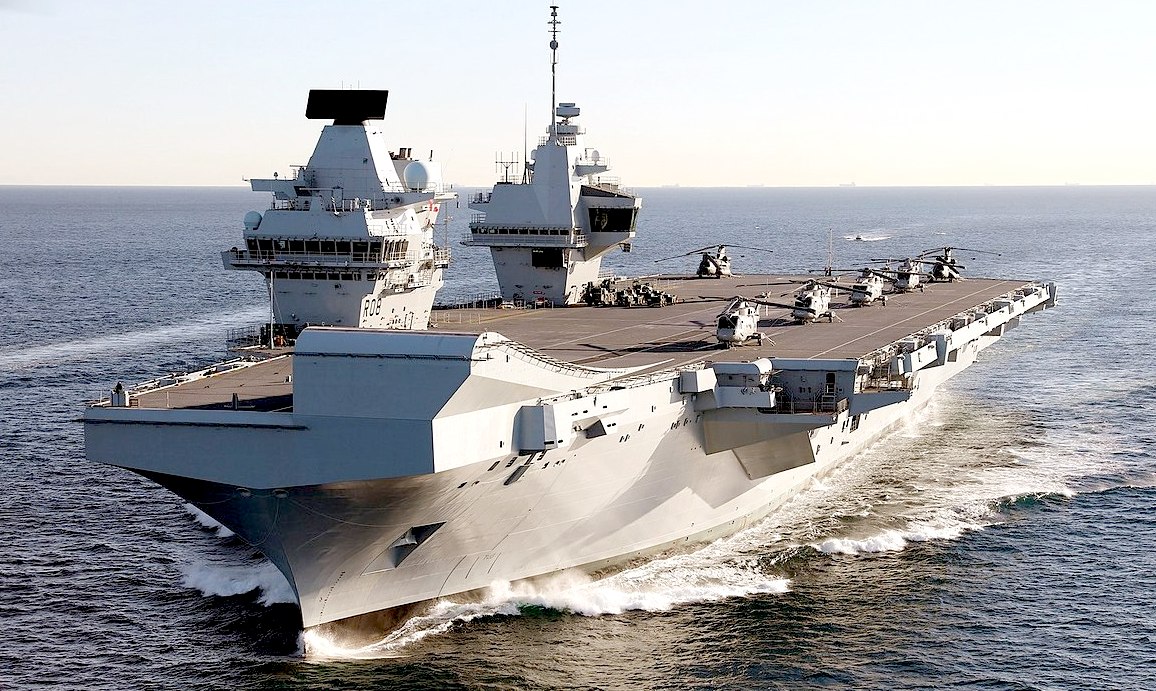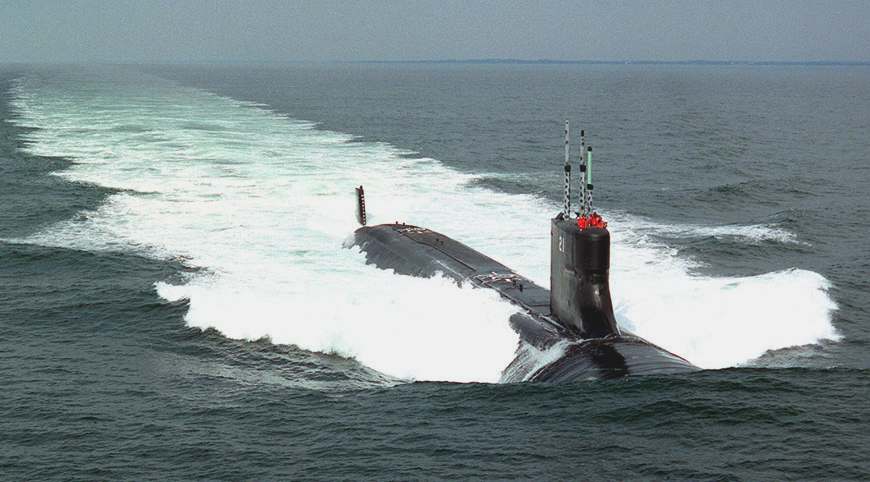|
ZERO EMISSIONS - BY TREATY
Please use our A-Z INDEX to navigate this site or return HOME
|
|
HMS Queen Elizabeth, allegedly built mainly to keep MOD subcontractors in the lap of luxury at the expense of the taxpayer and rising National Debt. The objective was to keep a skilled workforce going, in times of peace, just in case of World War Three. But there are much cheaper and less dangerous methods of demonstrating military might, without all those white uniforms to pay for and without the nuclear weapons, that are now banned by the United Nations.
The environmental impact of shipping includes greenhouse gas emissions, acoustic, and oil pollution. The International Maritime Organization (IMO) estimates that Carbon dioxide emissions from shipping were equal to 2.2% of the global human-made emissions in 2012 and expects them to rise between 50 to 250 percent by 2050 if no action is taken. Ocean pollution takes many forms. We should be aiming for zero pollution, from net zero growth, if we are to achieve a sustainable, circular, economy.
PEOPLE POWER - Most unreasonably, in our view, the UK government refused to participate in the Weapons treaty talks and says it will 'never' sign to ban nuclear missiles, but then Margaret Thatcher thought she could rule the will of the people with her Poll Tax, ending with her resignation in disgrace, awash with tears as she was driven from Number 10. Such fall from grace proving that politicians who ignore the wishes of the people do so at their peril!
The anti nuclear weapons treaty is a victory for grassroots campaigning for common sense to prevail. The 2017 Nobel Peace Prize was awarded to ICAN for its tireless work in campaigning for this momentous achievement. According to other online publications, 59% of the UK public want the government to sign. 52 countries have ratified the agreement, with a further 86 signing it.
UN NUCLEAR WEAPONS BAN JANUARY 22 2021
The Treaty on the Prohibition of Nuclear Weapons, the first international ban on nuclear weapons, came into force on
January 22nd 2021.
International treaties reinforce norms and provide a forum to discuss and condemn violations of international standards for peace and security.
Where North Korea is playing catch-up, signs of cease-fire internationally may play a part in persuading new faces as to the futility of wasting climate dollars entering the cold arms race that nobody wants other than the military, hoping to build their part.
UNSUSTAINABLE POLICIES
In our view it is madness to allow anything on or under the sea that could alter the ecology of the ocean. It's bad enough that there are diesel engines plying the waves in great numbers, using tons of dirty bunker fuel, but at least that is now recognized as a problem, with the IMO introducing phase out targets - to achieve clean shipping by 2050.
How then to get the world's super powers to stop building vessels (weapons) that pose a huge threat to marine life. The only solution we can think of is vote for a green party candidate. This may mean tightening your belt, but it also means surviving the anthropocene age that is boiling our oceans and turning arable land to deserts.
Assuming that we can stage a climate recovery, we don't want military lunatics dumping waste all over the place, just to keep on playing power games, when the world belongs to no man. The world belongs to everyone, and the majority do not want nuclear waste creating another problem that may be insurmountable.
The United Nations has recently outlawed nuclear weapons. A major achievement that the majority of member states will be rightly proud of. Those nuclear powers reluctant to obey the majority decision can only be cajoled to acquiescence. For we do not want any more confrontations that could further threaten our already overheated climate.
Unfortunately, reducing a carbon footprint also means reducing a nuclear footprint in our view.
You can read below the difficulties in the extracts from US military advice as to the containment technicalities and cost of decommissioning a nuclear powered vessel - and decide for yourself if:
a) the cancer risk is acceptable b) the carbon cost is acceptable
We think not! But in order to get the super-powers to see the light, we need a more stable global economy based on sustainable practices. This is called the Circular Economy.
In order for the super-powers to see the light, other nations with aspirations to becoming a nuclear power, might also want to adjust their viewpoint - to help defuse the perceived need for weapons of mass destruction.
ZERO RADIATION & CARBON: The Elizabeth Swann shown above, is a zero emissions vessel, using only solar and hydrogen power for propulsion. She could have a boosted performance as a hydrogen hybrid, to provide high speed transits as a ferry, though 10 knots constant is achievable in theory using only onboard renewables. The shipping world may like it more if they can just fill up in ports, as they are at the moment.
The propulsion plants of nuclear-powered ships remain a source of radiation even after the vessels are shut down and the nuclear fuel is removed. Defueling removes all fission products since the fuel is designed, built and tested to ensure that fuel will contain the fission products.
Over 99.9% of the radioactive material that remains is an integral part of the structural alloys forming the plant components. The radioactivity was created by neutron irradiation of the iron and alloying elements in the metal components during operation of the plant. The remaining 0.1% is radioactive corrosion and wear products that have been circtiated by reactor coolant, having become radioactive from exposure to neutrons in the reactor core, and then deposited on piping system internals.
GREAT TECHNICAL ACHIEVEMENT: But do we still need the ability to blast the world to bits. Are we really that stupid? Most of the concerned public are not, but some politicians appear to believe that the ability to annihilate life as we know it, is a good thing. Policy makers use public money for such domination ambitions, keeping the electorate in the dark as to where their taxes are going. Arming for war is just one step from pushing the button. Politicians should use their positions of trust to negotiate and debate in Parliament, aiming for a common sense unilateral downsizing and eventual elimination of hazardous practices.
DECOMMISSIONING
AND DE-FUELING
Most of the nuclear-powered cruisers will be removed from service, and some LOS ANGELES Class submarines are scheduled for removal from service as well. Eventually, the Navy will also need to decommission 0HIO Class submarines.
US Navy nuclear-powered ships are defueled during inactivation and prior to transfer of the crew. The defueling process removes the nuclear fuel from the reactor pressure vessel and consequently removes most of the radioactivity from the reactor plant. Defueling is an operation routinely accomplished using established processes at shipyards used to perform reactor servicing work.
A disposal method for the defueled reactor compartments is needed when the cost of continued operation is not justified by the ships military capability or when the ships are no longer needed. After a nuclear-powered ship no longer has sufficient military value to justify continuing to maintain the ship or the ship is no longer needed, the ship can be:
(1) placed in protective storage for an extended period followed by permanent disposd or recychg; or
(2) prepared for permanent
disposal or recycling. The preferred alternative is land burial of the entire defueled reactor compartment at the Department of Energy Low Level Waste Burial Grounds at Hanford, Washington.
Prior to disposal, the reactor pressure vessel, radioactive piping systems, and the reactor compartment disposed package would be sealed. Thus, they act as a containment structure for the radioactive atoms and delay the time when any of the radioactive atoms inside would be available for release to the environment as the metal corrodes.
This is important because radioactivity decays away with time; that is, as time goes on radioactive atoms change into
non-radioactive atoms. Since radioactivity decays away with time, the effect of a delay is that fewer radioactive atoms would be released to the environment. Over 99.9% of these atoms are an integral part of the metal and they are chemically just like ordinary iron, nickel, or other metal atoms. These radioactive atoms are only released from the metal as a result of the slow process of corrosion. The remaining O.1%
- which is corrosion and wear products - decay away prior to penetration of the containment structures by corrosion.
The estimated total Shipyard occupational exposure to prepare the reactor compartment disposed packages is 13 rem (approximately 0.005 additional latent cancer fatalities) for each LOS ANGELES Class submarine package, 14 rem (approximately 0.006 additional latent cancer fatalities) for each 0~0 Class submarine package and 25 rem (approximately 0.01 additional latent cancer fatalities) for each cruiser package.
You have got to be joking, right! It's bad enough that they are over-fishing the northern seas, but then to deliver such cargoes of frozen fish by nuclear powered ships is madness. Why not just inject us with cancer cells and get it over with, or start selling tickets to their new holiday camp at Chernobyl. Russia needs to consider employing better PR staff!
RUSSIAN PLANS FOR NUCLEAR CONTAINER SHIP - September 9 2019
NUCLEAR SHIP SAVANNAH
NS Savannah was the first nuclear-powered merchant ship. She was built in the late 1950s at a cost of $46.9 million (including a $28.3 million nuclear reactor and fuel core) and launched on July 21, 1959. She was funded by United States government agencies. Savannah was a demonstration project for the potential use of nuclear energy. The ship was named after SS Savannah, the first steamship to cross the Atlantic ocean. She was in service between 1962 and 1972 as one of only four nuclear-powered cargo ships ever built. (Soviet ice-breaker Lenin launched on December 5, 1957, was the first nuclear-powered civil ship.)
The Tonight Show Starring Johnny Carson featured "Nuclear Week In New York" on two programs. Dr. Glenn T. Seaborg, Chairman of the Atomic Energy Commission, was the featured speaker and President Eisenhower was honored for his introduction of the global Atoms for Peace program. The appearance of Savannah and the Nuclear Week festival program was designed and implemented by Charles Yulish Associates and supported by contributions from leading energy companies.
Horizon Europe is the EU's next research and innovation programme starting in 2021, with the Green Deal.
HORIZON-CL5-2021-D5-01-07
Enabling the safe and efficient on-board storage and integration within ships of large quantities of ammonia and hydrogen fuels (ZEWT
Partnership) IA to TRL 6-7 Budget € 20m Around €10m
x 2 projects
LINKS & REFERENCE
EDF ELECTRICITY FRANCE NUCLEAR POWER STATION UK TAXPAYERS LEFT WITH £BILLIONS TO PAY FOR CLEANING UP RADIOACTIVE WASTE https://cnduk.org/ https://antinuclear.net/ https://thebarentsobserver.com/en/industry-and-energy/2019/09/here-comes-nuclear-powered-cargo-loaded-seafood
Please use our A-Z INDEX to navigate this site
|
|
|
This website is Copyright © 2022 Jameson Hunter Ltd.
|








